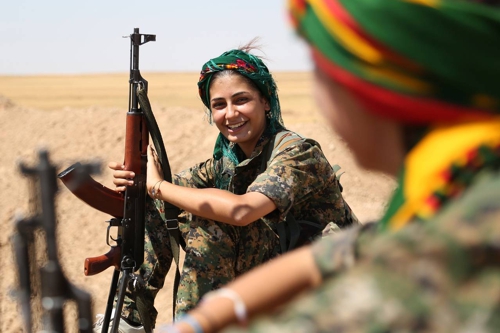On 9 Oct 2019 the Turks finally made good on their threats and invaded northern Syria. The US betrayed the Kurds, yet again, by pulling their troops back from the border of Turkey and commanding the Kurds to dismantle their posts there. Then began the Turkish operation code-named “Peace Spring” – an ironic name, really. However, it may bring just that in the second quarter of 2020, but probably not to the overall liking of the Turks or Washington. We’ll see why as we go along. Rojava may have just been consigned to the realm of dreams rather than reality.
Operation Peace Spring (below, bigger) is a Turkish offensive aimed at creating at safe/buffer zone extending 30 km deep into Syrian territory from the Turkish border. The goal is to prevent incursions into Turkey by SDF fighters and the PKK, who have supporters in Turkey. An unstated aim is to cut the M4 highway which runs west to east across the north of Syria, which would prevent resupply between SDF forces. That highway is about 30 km inside Syrian territory. Most of the Kurdish forces are in that desired buffer zone.
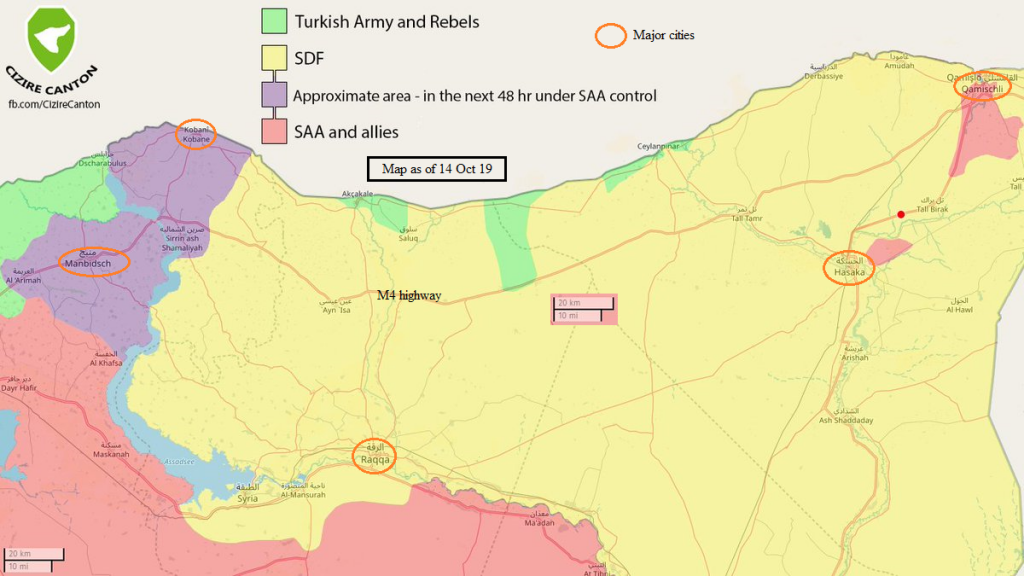
The chart for the start of the operation is below (bigger). There are actually two charts, because the operation started in the vicinity of two cities – Ras al-Ayn and Tall al-Abyad, giving rising degrees a couple of degrees apart. That matters little when looking at the overall operation because the rulership of the Horizon at the 7th house (Mercury) doesn’t change. Even if the operation had started earlier, it still would not have made any difference to the outcome (with Venus ruling then). Why, we might ask? – because both Mercury and Venus oppose Uranus in the event chart. The operation was never going to go as planned, and there were going to be sudden and unexpected changes.
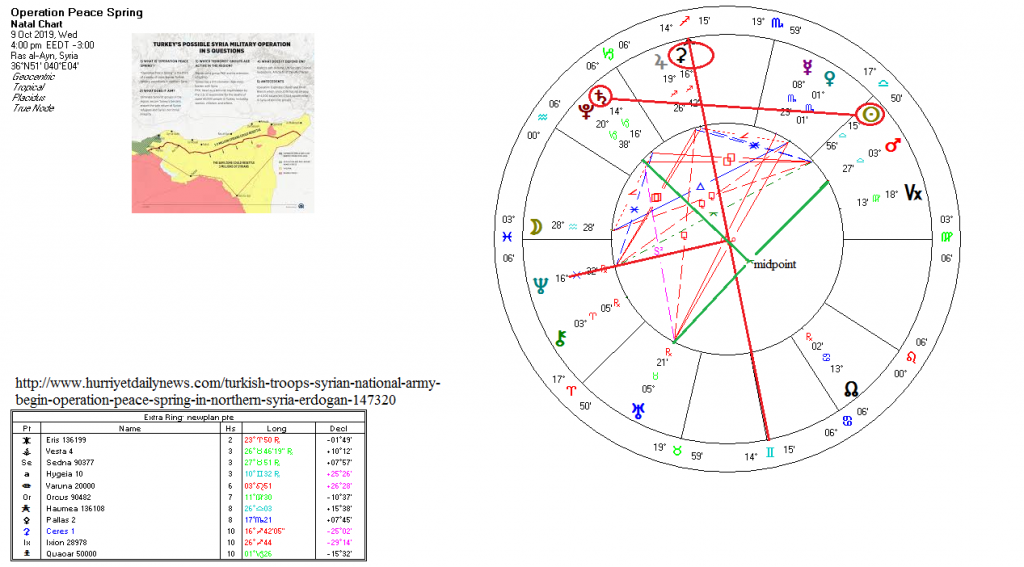
To begin, there is a video that is worth watching which gives the background on what is taking place in Syria now and the reasons for it. With that background, we will dispense with the event chart and then move on to the larger picture. The main features of the chart are the midpoint structure Plu=Mars/Ura, Neptune squaring the Meridian axis from the 1st house (the target group, the Kurds), Ceres conjunct the 10th house in the 10th (a turning point in the war) conjunct Jupiter and square Neptune, the Sun having just passed the square with Saturn, and then the ruler of the 7th (the belligerent) in the 8th house opposite Uranus in the 2nd house.
The midpoint structure shows the violence of the event and the ‘intervention of a Higher Power’. Whether the intervention was of a Higher Power is debatable, but the Turkish forces against the Kurds alone are the superior military force. The Kurds without air support are essentially defenseless, as the area they occupy in Syria is flat, desert and sparsely populated. The only defensible positions are in the cities, where there are also large numbers of civilians. With the Americans having withdrawn their air support and ground forces, the Kurds are sitting ducks outside the cities.
The square between the Sun and Saturn shows the ambition of the Turks, the heaviness of the situation, an event that speaks of reckoning and a desired decisive outcome. But then, with the other factors, do we really know what that outcome will be? That brings in the Neptune square from the 1st house, which represents the Kurds here.
The outcome of this conflict depends upon the decisions the Kurds make with regard to with whom they ally themselves, and if they decide to ally themselves with anyone. It turns out they have, which will be covered more fully in the next article. That decision is based in the Neptune placement, which also represents their uncertainty, exposure and relative weakness. But the square to the Meridian also points to their being caught between their dreams of their own independent state (Rojava/4th house) and the government in Damascus (10th house). Seeing that the US has now used and betrayed them for the 8th time now since 1923, the Kurds have thrown their hat into the ring with Damascus, and by extension, with the Axis of Resistance and Russia. The Russians are seen as more reliable partners than the US these days.
Finally, we have the Mercury opposition with Uranus. The Mercury rulership of the Virgo 7th house points to the fluid nature of the offensive, as well as its taking place within Syria (ruled by Virgo). The Virgo placement also infers that this is an ethnic cleansing operation. Mercury receives no other major aspects aside from a quintile with Pluto. By reflection, that shows the obsessive nature of the Turks regarding the Kurdish ‘threat’.
The Turks regard the Kurdish PKK and YDF as terrorists. But the quintile also shows that there are possible disasters in the making (as in “the best-laid plans of mice and men…”) for their initiative, which is further enforced by the opposition to Uranus. That opposition itself is a belligerent placement and balks against any sort of external authority. The Turks were repeatedly warned not to invade, but did so anyway. Finally, the opposition/quintile shows that there will be many twists and turns in the fight, and that it will not go as planned. That is true of any war, but it is also especially true of this one.
The Kurds, represented by Neptune and Jupiter, the latter in the old rulership, are in a stronger position astrologically than the Turks. Jupiter is sextile the Sun. In this case the sextile does not indicate a successful operation by the Turks – unless…(more on that in a bit) – but instead supports the Kurds. That is reinforced by the Neptune sextile with Saturn, the latter in the 11th house (alliances), the square with Jupiter and the quincunx link with the Sun. In all, it is not the most stable of setups, but what we have emerging is a very fluid situation anyway, again shown by the Neptune and Mercury contacts and influences. From here, we go to a bit of background in order to discern where this will probably go in the end.
Trump announced the withdrawal of the American forces on the 6th. The Invasion started 72 hours later. In his announcement, with his “great and unmatched wisdom”, he stated that Turkey had better not overstep its bounds (whatever that meant) or he would ruin their economy, and that they would be responsible for all Daesh fighters in the area, as none of their parent countries wanted them back and further, that the American taxpayer should not be responsible for detaining them.
The damning of Trump’s announcement was swift and harsh, speaking of the betrayal of allies and so forth, and about what a bad move it was, opening the door for Daesh to reconstitute, etc. Some of Trump’s biggest supporters, including evangelical leaders, turned on him. But what choice did he have? To step back a moment, what was going on with his chart in those days? His chart with transits is below (bigger):
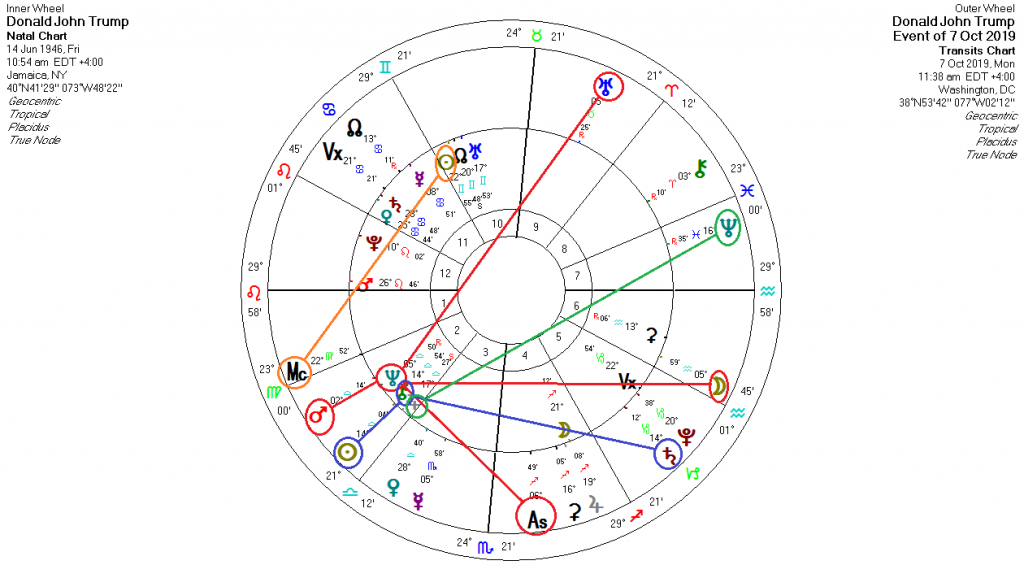
He has been under a fair amount of stress lately, with threats of impeachment and so forth, shown by the transits of the Sun and Saturn affecting his Chiron, and making him quite defensive. Neptune has been transiting quincunx his Jupiter, inflating his self-confidence, but unduly so. It is currently separating but it has been there for some months and will return after it turns direct in the last of this year. In addition, Mars was approaching his Neptune, a transit that speaks of inflamed misconceptions, added to by Uranus being quincunx his Neptune. And the transiting Moon was trine his Neptune at the time of his tweet, further exacerbating matters. Finally, the Midheaven at the tweet was square his Gemini Sun. Add all that together, and in some ways he just couldn’t help himself with his hyperbole.
The reason his tweet is brought up is because it has only made matters worse with the Turks, whom the Beltway is trying to get back on-side. Trump has already imposed sanctions on the Turks for the invasion, but this would appear to be more of a face-saving measure, as it will not do much to stop the invasion. But, Trump was not alone in his decision to withdraw the troops, though, and he said as much. The new US Defense Secretary, Mark Esper, acknowledged that the US troops were between the hammer and the anvil, and that the US did not sign on in NE Syria to fight the Turks:
…if the US troops weren’t withdrawn, they would be caught between two warring factions – the Turks in the north and the SDF, possibly with the Syrian Arab Army.
“And so we find ourselves as we have American forces likely caught between two opposing advancing armies and it’s a very untenable situation. So I spoke with the president last night after discussions with the rest of the national security team and he directed that we begin a deliberate withdrawal of forces from northern Syria.”
Essentially, the US troops are caught between their allied NATO troops and the enemy “Assad regime”, between the hammer and the anvil.
So, despite what we hear in media of all sorts, the decision to withdraw troops was not some crazy, unilateral, ill-thought move by Trump to effect some sort of campaign stunt, a ‘win’. It was the considered opinion of the National Security team.
This needs to be seen in context. Was this a betrayal of the Kurds by Trump alone? The short answer is no. The Kurds were set up from the start, in 2014, when they allied themselves with US forces in the fight against Daesh. They have been used as cannon fodder and proxy forces many times in the past century. The latest was under the Obama administration and before that by the Bush White House. The use and subsequent betrayal of the Kurds has gone across nations, administrations and party lines. Protestations by Washington’s politicians are essentially hypocritical.
And then, there were ulterior motives by other foreign actors as well in the Kurdish alliance, including Israel and the Saudis. The alliance was meant to tear away a part of Syria, to balkanize it, thus weakening the Syrians. The Turks objected strongly, as the US had armed the Kurds to the protestations of the Turks, meaning that an armed and battle-hardened group that the Turks view as terrorists were sitting there on their border. Erdogan was never going to allow that for very long.
The Turks had been planning and warning of this invasion for a long time. If the US had stayed in the face of the invasion they would have been fighting against a NATO ally, not that Turkey is on particularly good terms with the US at the moment.
What will this mean for Syria and Assad, then? The chart for Syria with transits and directions is below (bigger):
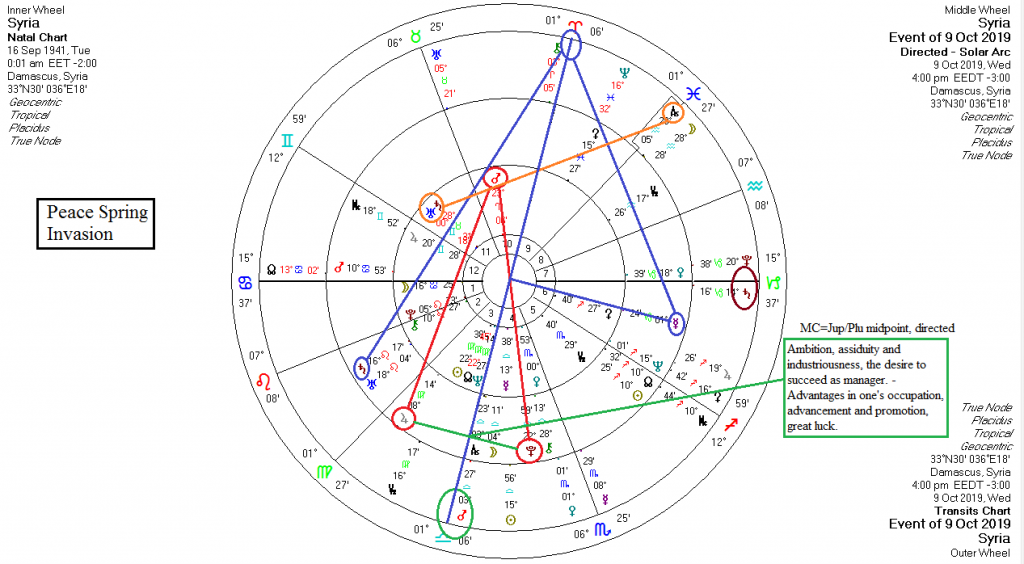
There are two directions of Mercury to consider. Firstly, there were mutual directions of Mercury and Saturn to the MC last year, showing a very considered approach to the overall situation by the Syrian government. That was when the Idlib ceasefire deal was struck, and became exact when the SAA began to liberate the southern portions a few months ago. Then, Mercury had moved up to the square of the Syrian Meridian, showing the changing situation, and was from the 6th house, showing the military operations that were undertaken. That has led to the present.
At present, at the bottom of the chart we see the Jupiter/Pluto midpoint has directed to the Meridian axis, with the effects shown in the green box. As it turns out, those are both also directed to Mars, ruler of the 10th house: “Organising talent, the ability to inspire others with enthusiasm, the desire for achieving great things.” The Syrians, regardless of who instigated this operation, are on a roll. The Kurds have now cut a deal with Damascus, and Syria has basically just regained the northeastern part of its territory – without much effort at all, at least yet.
So, here is a big question, given Peace Spring began with Neptune in the 1st house: Was this all just a big scam to get the Kurds back on board with Damascus and the Americans out of northeastern Syria? It’s a legitimate question, referring back to the “unless…” mentioned previously. Would the American establishment have been in on it? Probably not, given that Washington is looking to spoil everything Russia and Assad touch and hence their hyperbole over Trump pulling the troops out. But there are two indicators that there is more to this than meets the eye, aside from the Neptune.
Firstly, Russia did not say too much when the operation started. What Putin did say was that all of the foreign forces inside Syria illegitimately (that word is left out of most reporting) had to leave. The forces there legally are Iran, Russia and Hezbollah, as they were invited there by Damascus.
Then, on the very day the American withdrawal was announced, Russian special forces opened a bridge across the Euphrates at Deir ez-Zur, in what would have been quite odd otherwise, as it would have incurred American reprisals. It was a clue that something was in the offing, because it meant that the SDF and SAA could be supplied from the rear if need be, safe from encroaching Turkish forces. Deir ez-Zur is some 80 miles or more from the M4 highway. However, there is a main road that goes there and the southern part of the SDF region needs access and resupply as well.
But the bridge at Deir ez-Zur is important for another reason: It is at the border of the al-Omar oil field, the largest in Syria. That had been taken by Daesh in the early days of the war, and then reclaimed by the SDF at the end of 2017. Now it is back in the hands of the Syrian government.
Tying all this together, then, we have the following:
- The Syrians have just regained a large piece of their territory, almost 30% of it, which includes the most valuable oil fields, and which will be essential in their efforts to rebuild.
- The Turks will eventually have the SDF/YPG and thus the Syrian PKK under Syrian control. The latter will be disarmed and reintegrated into the SAA, thereby posing no threat to Turkey.
- The Turks will be able to send the millions of Syrian refugees home, most of them Sunni Muslim, thus lessening their financial and resource burdens. However, that could pose potential problems in the future, as the Kurds are a minority in the region.
- The Americans will be out of Syria except for Al Tanf, where they will not be much trouble. The Syrians can work around them for the time being.
- The Israelis have lost out, as they wanted Syria to be partitioned, which would have made their security concerns lesser. But that also means that Syria will at some point be coming after the Golan. Their Syrian problem just got worse. And now the Russians are chasing away their jets. We have not heard of an Israeli bombing raid in Syria in recent weeks, especially since the Israeli elections.
- Idlib will be cleared of militants soon, as in months, once the northeastern area has settled down. The Turks have abandoned those militants, who were used as proxies, in similar fashion to the US and the Kurds.
- Trump has openly called out the conflicts in the Middle East as ill-conceived and wasteful of trillions of dollars, out of taxpayers’ pockets. It is an announcement that has not gone down well in the Beltway.
The preceding are just a few points on what is an evolving situation, but which also marks the start of the final battles of the Syrian war. We have either just witnessed one of the most brilliant diplomatic moves in recent memory, one that gives win-wins all around, or a perfect storm of events that have conspired all at once to give all the belligerents in the war a face-saving way out of it. We can probably bet on the former. Why would we say that, and recapping some of the preceding points?
- Both Trump and Erdogan get to throw a bone to their voter bases – Trump because he ended one of America’s endless wars (so he will say) and Erdogan because he was proactive and fought the PKK. Trump gets a distraction from his impeachment proceedings and Erdogan can focus on the Turkish economy once the fighting has stopped, plus sending millions of Syrian refugees home.
- Syria gets back a large chunk of its territory, its citizenry and its oil fields (eventually), and frees up forces to clear out Idlib. It also gains more battle-hardened military forces along with their philosophy. The move also clears out the largest number of Americans from Syria, along with French and British troops. And it saves the Kurds from being massacred.
- The Russians emerge as the go-to diplomatic corps in the Middle East, and probably elsewhere too, as solid and trusted negotiators and partners, much as we in the West may dislike it.
- The US and Turkey can begin to mend fences, as the PKK threat has been removed and the two largest militaries in the NATO will no longer be at odds.
There is one more piece to add here, before we get our hopes up about the US forces leaving Syria. Word is coming out now that US forces will stay in the oil fields, which makes a lie of any claims that the troops are coming home. They have only been reassigned if staying at the oil fields is the case. The plan is still to attempt to starve out Assad. Given the way things are going, that is unlikely to happen. It would appear to be only a matter of time before yet another breakthrough moment comes and the US is forced to leave.
The Kurds are no worse off now than when the war started. And when political discussions begin in the days ahead, they may actually find themselves in a better position than before. Cynics in the US will say that Assad will exact reprisals, but the Kurds now represent security forces on the Turkish border. Assad, if anything, is pragmatic, given his behavior during the course of the war. Integrated with the SAA, the Kurds would no longer represent a threat to Turkey, and they have proven their mettle in battle.
There will still be missteps and surprises in the days ahead, but since the Kurds have now allied with the SAA, this has been a breakthrough – and it happened on the full moon, referring to the Libra letter – in what was otherwise an interminable stalemate in that region of Syria, one that will prove valuable to the Syrians. It should also lead to better treatment for the Kurds under what will be a renewed Syria when the conflict is ultimately resolved. We’ll have a look at that in the next installment.
Featured pic from The Wall Street Journal

